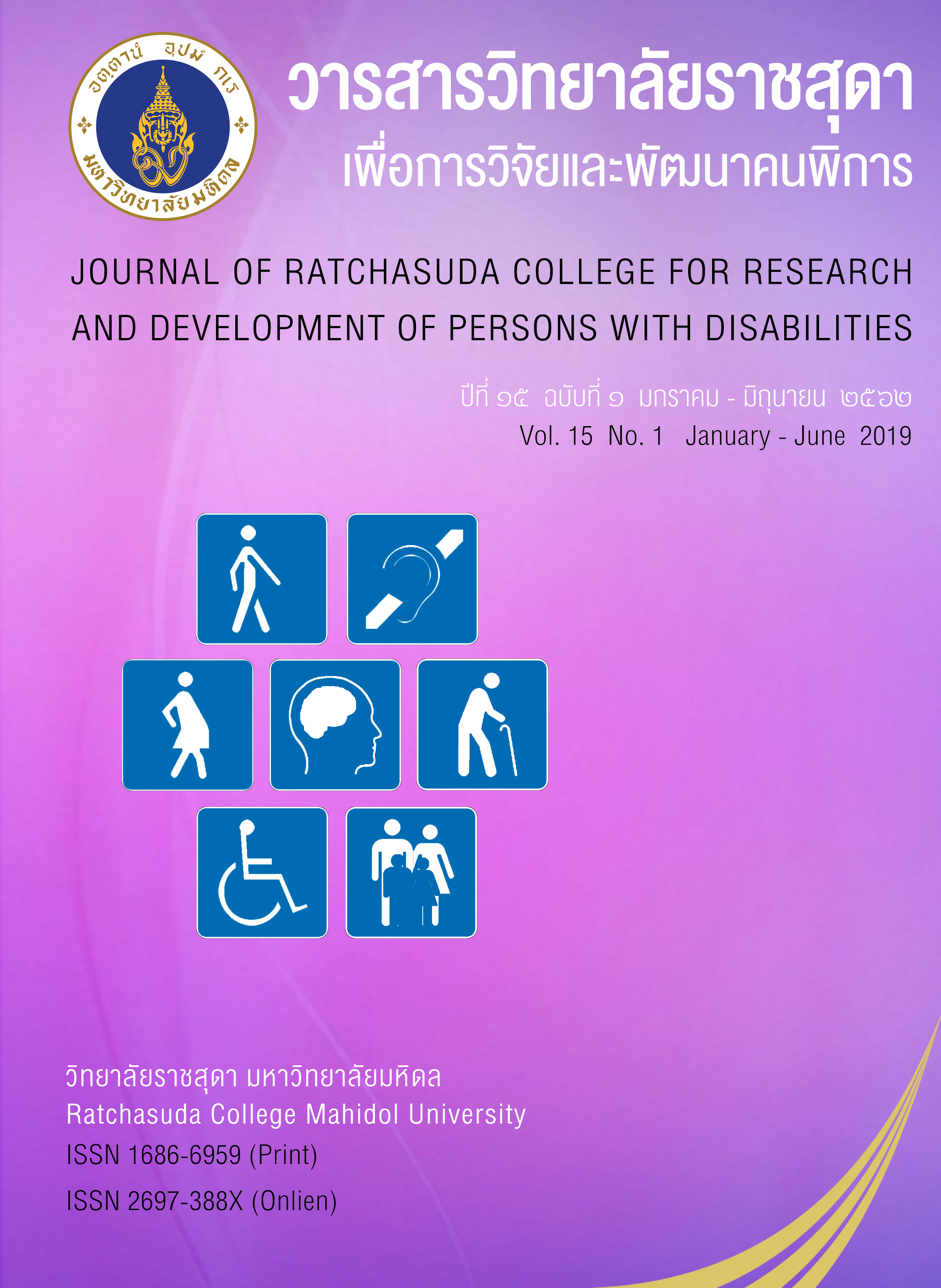Appropriate Types of Job and Career for Adults with Autism Spectrum Disorder
Keywords:
Adults with Autism Spectrum Disorder, Appropriate Types of Job and Career for Autism Spectrum Disorder, Employment Strategy for Autism Spectrum DisorderAbstract
Autism spectrum disorder (ASD) has abnormal developments of communication skill, Autism spectrum disorder (ASD) has abnormal developments of communication skill, social skill and behavioral characteristics. The increasing prevalence of ASD needs to be addressed. Services and supports are needed to help them achieve employment success. Adults with ASD have the ability and desire to work, especially in ASD with high function. Moreover, ASD employment has a significant cost impact on the economy. This paper aim to review evidence based researches related to employment for adults with ASD and illustrates characteristics of ASD, state of employment, appropriate types of job and career for ASD, and strategies for success. For the state of employment, we found that adults with ASD are unemployed more than employed. ASD often have a better long-term memory than most normal people; therefore suitable jobs for them should depend on using long-term memory rather than short-term memory and have visual thinking assignments. Strategies for success of employment include 1) job placement 2) supervisors and co-workers or job coaches 3) on-the-job training 4) work place modification and 5) long-term and continuous support.
References
Center of Disease Control and Prevention. (2018). Prevalence and characteristics of autism spectrum disorder among 4-year-old children. Retrieved from https://www.cdc.gov/ncbddd/autism/articles.html
Chalongkraeun, R. (2016). 10 Organization-Private Sector turn to hire ASD. Retrieved 3/March/2019 from https://mgronline.com/qol/detail/9590000031166
Department of Empowerment of Persons with Disabilities. (2017). Ministry of Social Development and Human Security. Annual report on the disabilities in Thailand. Retrieved from https://drive.google.com/file/d/0B7zm DKP8VFLaTTNBbnh 5RGczUjg/view
Grandin, T. (1999). Choosing the right job for people with autism or asperger’s syndrome. Retrieved from https://www.indiana.edu/page/Choosing-the-Right-Job-for-People-with-Autism-or-Aspergers-Syndrome
Hendricks, D. (2010). Employment and adults with autism spectrum disorders: Challenges and strategies for success. Journal of Vocational Rehabilitation, 32, 125-134.
Hillier, A., Campbell, H., Mastriana, K., Izzo, M., Tucker, A., & Cherry, L. (2007). Two-year evaluation of a vocational support program for adults on the autism spectrum. Career Development
for Exceptional Individuals, 30 (1). 35-47.
Howlin, P., Alcock, J. & Burkin, C. (2005). An 8 year follow-up of a specialist supported employment service for high-ability adults with autism or asperger syndrome. The International Journal of Research & Practice, 9(5), 533-549.
Howlin, P., Jordan, R. R. & Evans, G. (1995). Distance education course in autism (Adults, Module 3, Unit 3), School of Education, Birmingham, UK: University of Birmingham.
Jarbrink, K., McCrone, P., Fombonne, E., Zanden, H., & Knapp, M., (2007). Cost-impact of young adults with high-functioning autistic spectrum disorder. Research in Developmental
Disabilities, 28, 94-104.
MGR online. (2016). 10 Organization-Private Sector turn to hire ASD. Retrieved 3/March/2019 from https://mgronline.com/qol/detail/9590000031166
Moxom, L., & Gates, D. (2001). Children with autism: Supporting the transition to adulthood. Education and Child Psychology, 18, 28-40.
National Organization on Disability. (2006). N.O.D./Harris Survey of Americans with Disabilities: Landmark survey finds pervasive disadvantages. Retrieved from http://w.w.w.nod.org/
content.cfm?id=15367.
Sanrattana, U., Chanpeng, P., Siriruk, P., & Sirinun, S. P. (2016). Current state, vocational needs of disabilities and case study of persons with autism spectrum disorder. Journal of Ratchasuda College for Research and Development of Persons with Disabilities, 12(15), 21-41.
Smith, D.D. (2004). Introduction to special education: Teaching in an age of opportunity. (5th ed.). Boston: Pearson Education, Inc.
Smith, M., Belcher, R. G., & Juhrs, P. D. (1995). A guide to successful employment for individuals with autism. USA: Paul H, Brookes Publishing.
Sriwongpanich, N. (2018). Only of 100 ASD in 18,220 ASD in Thailand has jobs with income. Retrieved 3/March/2019 from http://www.bangkokbiznews.com/news/detail/797549
Thailand. (2013). The Person with Disabilities Empowerment Act, (second amendment) B.E.2556. Government Gazette. Royal Decree 130 (Section 30 A), Bangkok: Thailand.
Triruangworawat, B. (2017). Research on gene of autism spectrum disorder and prevalence. Retrieved from https://www.dmh.go.th/news-dmh/view.asp?id=26705
United State Department of Education. (2005). Office of Special Education Program. Twenty-seventh annual report to congress on the implementation of individuals with disabilities education act, 2005. USA.
Wagner, M., Newman, L., Cameto, R., Garza, N., & Levine, P. (2005). After high school: A first look at the post-school experiences of youth with disabilities. A report from the national longitudinal transition study-2 (NLTS-2). Retrieved from https://eric.ed.gov/?id=ED494935
Downloads
Published
How to Cite
Issue
Section
License
บทความที่ได้รับการตีพิมพ์เป็นลิขสิทธิ์ของวารสารสถาบันราชสุดาเพื่อการวิจัยและพัฒนาคนพิการ





